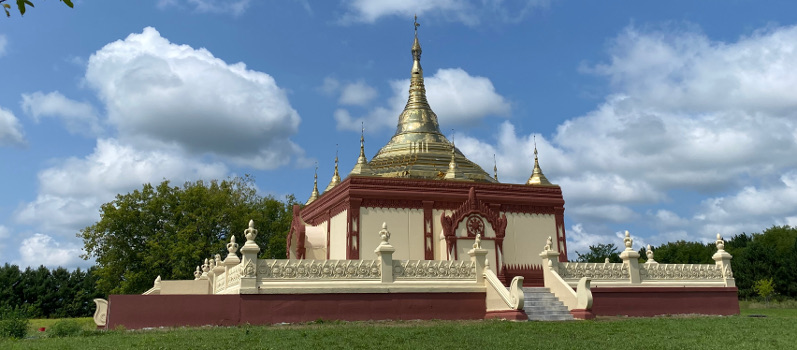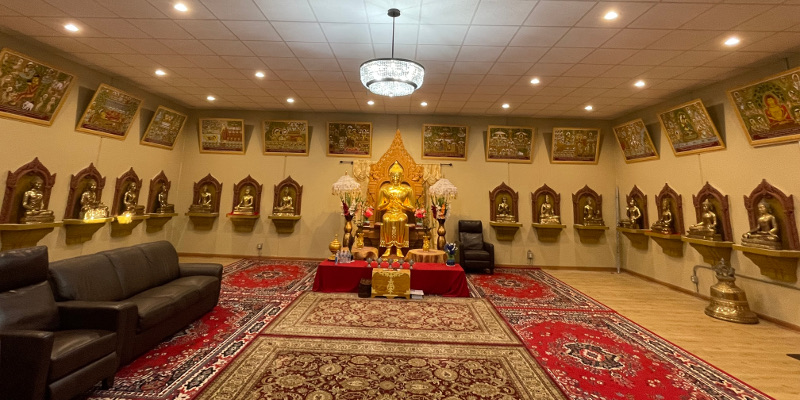Attractions of the Dhamma Vihara
The Shwedagon Pagoda

The Shwedagon Pagoda in Minnesota has quickly become a local landmark. Completed in 2019, it is a much smaller replica of the famous pagoda in Myanmar of the same name. The dome of stainless steel (not read gold), manufactured in Myanmar and assembled on site, stands 27 feet above a 36’ x 36’ assembly hall. The entire structure stands on a 72’ x 72’ raised plaza. The assembly hall, used for ceremonial purposes, is a consecrated space in which decisions of the Sangha (monastic community) are valid, according to procedures established by the Buddha. For example the ordination of a new monk through consensus of a quorum of Sangha members has occurred within the assembly hall on several occasions.
The assembly hall will soon contain a a number of statues, each depicting the Buddha. The smaller statues are replicas of statuary from various locations and eras of Asian Buddhist history. The railing surrounding the raised plaza is marked by a repeated series of symbols that represent the four major events of the Buddha’s life: lotus flower (birth), bodhi tree (awakening), Dharma wheel (beginning of teaching career) and stupa (parinibbana, or death of an awakened one). Please feel free to take pictures, but take your shoes off before entering any building.

The Shwedagon Pagoda in Myanmar is one of the most famous pagodas in the world stands some 300 feet tall atop a hill, where its golden roof illuminates Yangon (Rangoon), Myanmar’s largest city day and night. Known as “The crown of Burma,” is traditionally thought to contain eight hairs of the Buddha. The main dome is gold-plated and topped by an “umbrella” containing over 7,000 diamonds, rubies, topaz and sapphires, and a massive emerald positioned to reflect the last rays of the setting sun. Buzzing with tourists and surrounded by flower and book stalls, souvenir and tea shops, it is a major pilgrimage site for Buddhist devotees, who circumambulate the pagoda or recite ancient scripture at its base.
What is a Pagoda? The Buddha was not a god, and is not worshiped as such. He was a wise and compassionate human, and is remembered as such. Remembrance of the Buddha traditionally focuses on the four major events of his life: his birth (represented by the lotus flower), his awakening (the bodhi tree), embarking on his teaching career (the wheel of Dharma) and his death (the stupa or burial mound). The pagoda represents the last event; it is a large stupa and traditionally contains relics, some portion of the cremated remains of the Buddha, and reminds us of the immaterial legacy of the Buddha. Pagodas are found throughout Buddhist Asia, in many different grand and elegant forms, to inspire faith and joy in the hearts of monastics and laypeople.




